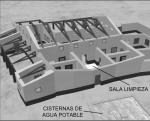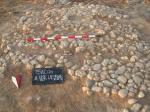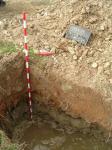Summary (English)
Research (2006-2007)
The Portus Ilicitanus Roman fish-salting factory was discovered in 1986 by a team from the Archaeology Section of the Maritime Museum of Santa Pola. Data obtained to date confirm the existence of a large industrial complex for fish salting dating to the Roman period.
During the 2006 and 2007 campaigns, the excavation of the western half of Department 35, as well as that of Departments 44-48 located north of Sector 1, was completed. Through these archaeological works we developed a complete plan of the vats(?) and the four sections that allow us to establish the complete chronological sequence of the three phases of the site in a large area.
Part of a house whose lime mortar pavement is 0.65 m below ground (Room 44) was found in Phase I.A number of structures with a pavement made of small stones and an elevation of 0.69 m below ground correspond to Phase II.
The walls of Stratigraphic Units 307 and 294 were demolished during Phase III to leave Department 48 free. The Department was paved with pebbles at the elevation of -0.45 m. In this moment the space between walls 307 and 294 is covered due to the construction of the Stratigraphic Unit 295 wall.In Department 45 we found remains from a pavement of earth and lime that covered a stratum of compact, orange earth with plenty of archaeological material (Stratigraphic Unit 588). The large amount of bone remains and several entire objects of common ware and glass stands out. The first bones localized and identified as human (skull, several ribs and vertebrae, and other dispersed bones) are located in the southeast angle of this department. These remains have been called Individual 1 and a small glass bottle , or ampulla,placed near the skull is associated with it.
Approximately 50 cm north we localized an entire female skeleton called Individual 2. It was linked to a burial deposit formed by a complete pot and a jar of common ceramic and glass remains. The skeleton was placed in a rectangular pit, surrounded by medium stones and demarcated in the area of the head by the Stratigraphic Unit 327 wall, where there were remains of a glass bottle. Several iron nails were found encircling the skeleton, leading us to think that Individual 2 was buried in a wooden coffin.
Finally, the northern end of this room, we found another complete skeleton, which we called Individual 3, and which we also think would have been buried in a wooden coffin because of the large amount of nails around it. The coffin would have been placed on a bed of medium and small sized stones that formed a rectangular grave excavated between the walls Stratigraphic Units 449 and 584. Associated with this individual were a bowl of common ceramic placed on the feet of the skeleton and a ampulla placed on the skull.
As the three burials of this room cut the walls and the floor of Phase II, they are from a later period. Moreover, the glass ampullae found next to two of the individuals show an arch that ranges from the 3rd century to the 5th century AD.
In Department 53, next to the Department 46 northwards, we localized a fourth burial that, unlike the previous ones, was covered by three tegulae and some large stones. One of the tiles, placed horizontally, covered the head, while the other two, placed in a double slope, covered the area at the feet closed in turn by a large stone. When we lifted the cover, we found a complete skeleton that we called Individual 4. Its bad condition was due to the pressure that the earth, together with the stones and tiles described, exerted on the bones after the disintegration of the wooden coffin. Next to this individual’s skull a small ampulla also appeared, with its neck of a longer size than the previous ones, and a large amount of coins, some dated from the second half of the 4th century AC.
In the southern area of the site is Sector 2, where we found some Early Roman structures and a large ceramic oven that, due to the materials found inside, seems to be linked to Phase 1 of the fish-salting factory (3rd century AC). In this context, we found some remains of surface structures that we considered appropriate to excavate in order to check their continuation, establish relations with the near structures and confirm the chronological development of this area of the site. These structures Sector 2 include a 50 cm-wide masonry wall of east-west orientation, and another wall, oriented north-south, forming a corner with the previous one.
From the analysis of these stratigraphic units, we can suggest that the beachfront was defined by the Stratigraphic Units 593 and 605 in the years of occupation of the settlement, which concurs with the surveys conducted by Fumanal and Ferrer. Stratigraphic Unit 593 provided archaeological material of great interest for the general understanding of the site. The East-West trench confirmed the absence of structures that continued those found in Sector 2 in this campaign, and did not offer any kind of archaeological material.
(translation by Alba López Fregeneda)
- Begoña Masanet Tamarit y Jaime Molina Vidal
Director
- Jaime Molina Vidal y Mª José Sánchez Fernández
Team
- Begoña Masanet Tamarit y Rogelio González
- Museo del Mar de Santa Pola (Sección de Arqueología)
Research Body
- Colegio Oficial de Doctores y Licenciados en Filosofía y Letras y en Ciencias de Alicante - Sección de Arqueología
Funding Body
- Dirección General de Patrimonio Cultural






![Download [PDF]](/excavation/skins/fasti/images/results/download_sml.png)




